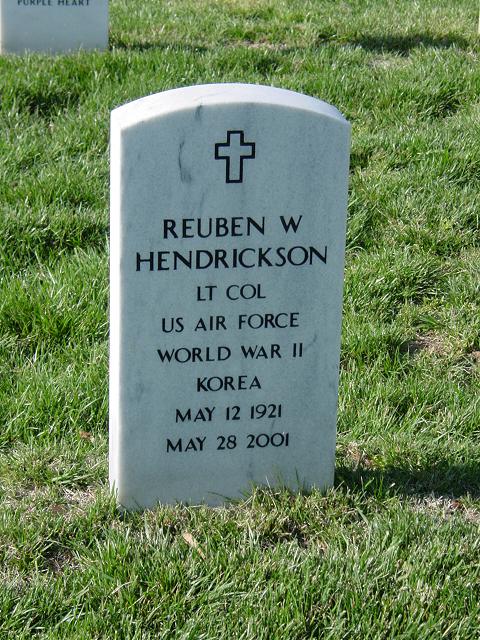Reuben William Hendrickson born May 12, 1921 in Tamarack Hill, Michigan and graduated from Dollar Bay High School in May 1939 with a partial scholarship to Michigan College of Mining and Technology. He attended MTU until the outbreak of World War II, when he signed up with the “Traveling Aviation Cadet Examining Board #1” on January 12, 1942. He attended Aviation Cadet Schools at Kelly Field, Chicasha Field, Randolph Field, and graduated at Moore Field, Mission, Texas, on September 6, 1942 in the largest class of military pilots from seven advanced flying schools of the Gulf Coast Army Air Forces Training Center since their inception. He was awarded his Wings, and commission as a Second Lieutenant, trained as a single engine fighter pilot.
He went to Drew Field, Florida, to hone in his flying skills on the P-39’s (80 transitional hours), and in the P-40’s (10 transitional hours) for 3 months.
He received orders for an overseas destination to begin on January 5, 1943. He left the United States on December 24, 1942, for Landi Field, Karachi, India, where he was assigned to the 10th Air Force, 51 Fighter Group, 25th Fighter Squadron. This Squadron’s main objective was to protect and defend Burma. In March 1943 he was transferred to the 14th Air Force, 23 Fighter Group, 74th Fighter Squadron in Yunnanyi, China under General Claire Chennault. After a surprise attack on this Air Field by the Japanese on April 26, 1943, which destroyed most of their planes, the 74th Squadron was moved to an airstrip at Kweilin, China, where he remained until his discharge from the War.
He was awarded the Air Medal for flying 25 missions, and the Distinguished Flying Cross for 50 missions flown during his 21 months in combat. Madame Chang Kai-Chek awarded to he and his Squadron with the “Third Order of the Golden Eagle” or the Chinese Air Medal. He left China in March 1944 and returned to Landi Field in Karachi where he helped train the new pilots coming into the war.
He returned to the States in September 1944, and continued his Army Air Corps career.
New assignments were stateside: Armament School at Buckley Field, Colorado, in 1945, and Strother Field, Kansas, participating in an operational training unit that was preparing new pilots for combat in P-47’s.
From August 1946 until April 1949 his assignments were: Maintenance Officer, Recruiting Officer and Statistical Control Officer at Grand Island, Nebraska, Statistical Control School at Lowry Air Force Base, Colorado, Armament Officer, Squadron Adjutant, Group Personnel Officer, Wing Legal and Claims Officer and Assistant Wing Personnel Officer at MacDill Air Force Base, Florida. In 1949, he joined the now new branch of service called the Air Force as a full time Officer, he was in the Army Air Corps Reserve until this time.
In 1950, he was appointed Commander of the 306th Air Refueling Squadron at MacDill. In February 1951 ordered to Headquarters 2nd Air Force at Barksdale Air Force Base in Shreveport La and made Chief of the Officer Assignments Branch in the Personnel Directorate.
On April 27, 1952 he departed for a temporary duty with the 307th Bombardment Wing stationed at Kadena Air Force Base in Okinawa, Japan. From May 1952 through December 1952 he was Director of Personnel for the 307th, and in addition, flew 6 night combat bombing missions over Korea.
He returned to Barksdale Air Force Base and was made Chief of the Airmen Assignments Branch in the Personnel Directorate, in April 1954, he advanced to the Chief of the Assignments Division. In 1956, he transferred to Maxwell Air Force Base to attend Air Command and Staff School.
His career continued at Bowling Air Force Base and working at the Pentagon until 1961 when he transferred to Europe, where he was Director of Personnel of the 366th Tactical Fighter Wing at Schulthorpe, England, and at Chaumont France, and again stateside at Holloman Air Force Base, New Mexico where he retired from the 366th Tactical Fighter Wing in December 1965 after 24 years of service to his country at the rank of Lieutenant Colonel.
Medals earned during his career:
Air Medal World War II
Distinguished Flying Cross
Good Conduct Medal
Air Force Commendation Medal (March 1958)
Army Commendation Medal (World War II) with one silver Oak Leaf Cluster
Distinguished Unit Citation (World War II)
Asiatic Pacific Campaign with Oak Leaf. (Presidential Medal)
American Campaign medal (World War II)
Asiatic Pacific Campaign with 4 bronze stars (World War II)
World War II Victory Medal
National Defense Medal World War II
Armed Forces Reserve Medal
Air Force Longevity Service Ribbon with 4 silver oak leafs (years of service in Air Force)
Korean Service Medal with bronze star
Korean Distinguished Unit Citation (Presidential medal)
United Nations Service Medal for Korea.
After his retirement from the Air Force, he worked for the Department of Intelligence through the Department of Defense until 1985 when he retired to enjoy his fishing, and gardening, and his grandchildren.
Colonel Hendrickson died on 28 May 2001 and wad buried with full military honors in Arlington National Cemetery.
HENDRICKSON, REUBEN W
- LT COL US AIR FORCE
- WORLD WAR II, KOREA
- DATE OF BIRTH: 05/12/1921
- DATE OF DEATH: 05/28/2001
- BURIED AT: SECTION 70 SITE 202
ARLINGTON NATIONAL CEMETERY
Michael Robert Patterson was born in Arlington and is the son of a former officer of the US Army. So it was no wonder that sooner or later his interests drew him to American history and especially to American military history. Many of his articles can be found on renowned portals like the New York Times, Washingtonpost or Wikipedia.
Reviewed by: Michael Howard

